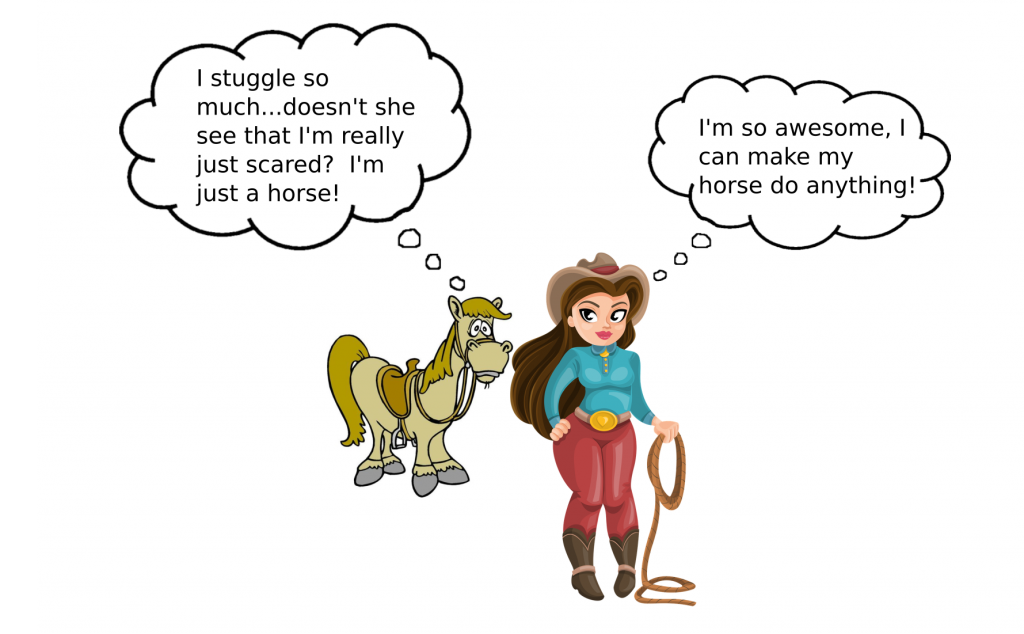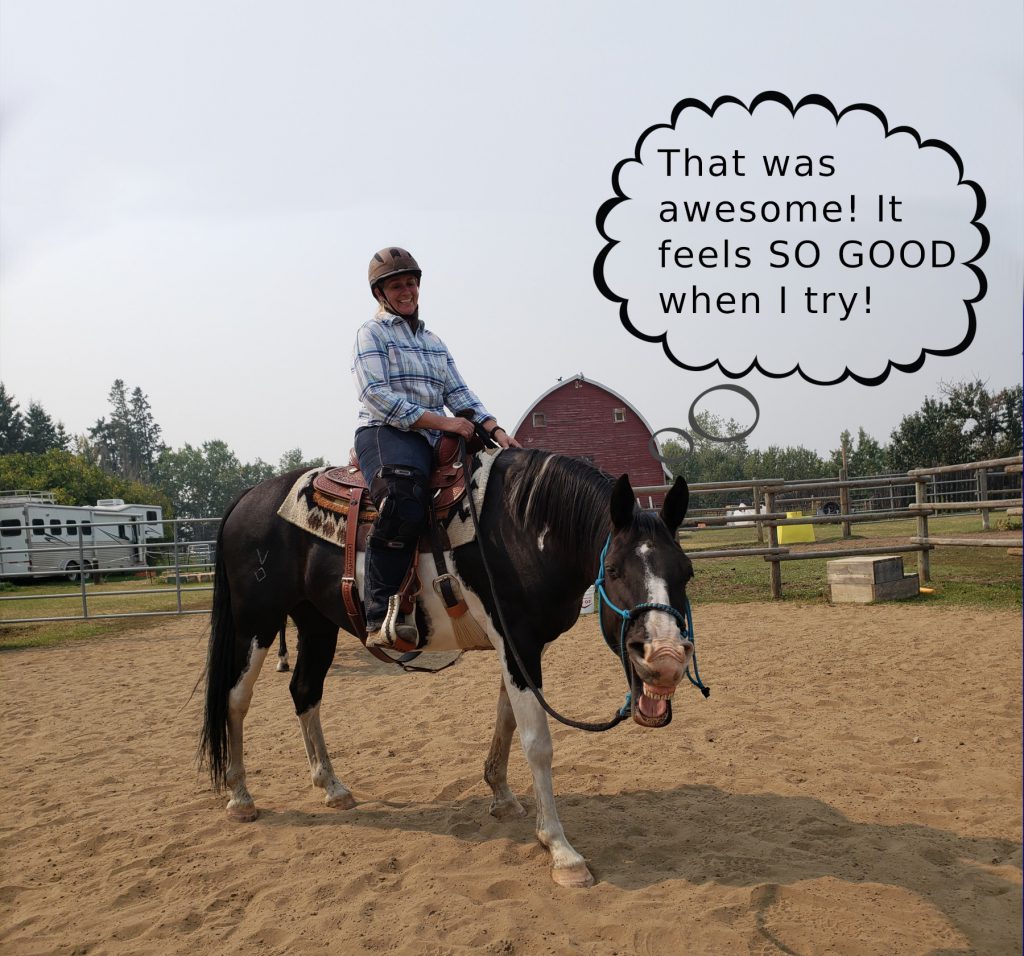I’d like to introduce five of our Strategies for Success that we follow when we start working with horses on obstacles or anything new and unknown.
- We build it in the groundwork, then ride it in the saddle.
- We never force a horse to go on, over or though something they’re scared of. We do go forward when the horse is in release and following our focus.
- Find ground zero. This is the position, proximity to an obstacle, or a maneuver that we know the horse can achieve. We can always start successfully from our ground zero point.
- We define success as, “anytime the horse tries for us,” and reward and encourage our horse when he tries.
- We allow the horse the time he needs to investigate the obstacle before we continue to ask him forward.
In this article, we’re going to focus on #4. You’ll need to read Part 1, Part 2 and Part 3 first.
The fourth point is an important one. It involves shifting our focus from this:

to this:

Lets start by agreeing on the following definitions:
-
- Goal. A goal is what you aim for. It might happen in an hour or it might take years. A goal is the end result; a culmination of individual successes that build on one another. A goal could be anything from winning a competition in 3 years time, to having your horse stand still while you mount. Goals help guide us on a path of successes. If we have no idea what we’re aiming for, it’s impossible to formulate a plan on how to get there. Having a goal causes our work to be productive. Although it’s important not to lose sight of our goal, it’s equally important not to focus exclusively on it. When training, our focus needs to be on the individual exercises that support our goal.
- Success. I define success as “anytime the horse tries for us“. Thinking this way can be a positive game-changer. It’s also one of the biggest struggles humans have. We struggle because we want the goal before the horse is able to provide it. We’ve cultivated a society of instant gratification where we expect we can have anything, anytime. You’ll find, however, that if you consider your job to be creating successes for the horse you’ll actually achieve your goals faster, with the benefit of building a committed leadership agreement with your horse.
- Try. A try is when the horse commits to an action that follows our focus. In short – we focus on a direction or action and put energy into that focus. Then, our horse essentially mimics us by sharing our focus and moving in the direction we desire. That might, in an initial instance, be taking one step. It might be moving only 6″. It doesn’t matter. The point is, you asked of the horse and he had enough commitment in your leadership to follow.
Lets say that we’re doing some groundwork and lead our horse, Jack, up to a box full of bits of pool noodles. Jack is wary. The closer we lead him, the more anxious he becomes. At some point, his focus goes off to the right. This is followed shortly by Jack looking to the right, then leaving to the right. Here’s what happened: when Jack’s ability to handle the pressure of the box hit a limit, his focus changed from following you to escaping the deathly scenario.
To help progress, we’re going to change up two things. 1. We’re going to be alert to Jack’s tension. When we see, sense or feel him get anxious, we ask him to release tension. We may need to stop at a distance from the obstacle where he is able to stand quiet. 2. We’re going to focus on where we want to go (see Where Do We Focus, below) and ask Jack to release tension. When he does, we ask him to move forward. From here on we repeat.
Where do we focus?
Where we focus depends on what need the horse has. Some horses will completely avoid looking at something they consider a mortal threat, as if to say, “If I don’t look at it, it doesn’t exist.” When a horse avoids looking at something, then a successful tactic is for us to focus on it and ask him to look at it. In our example, that might be asking Jack to release and follow our focus to the middle of the box. This will generally spark his curiosity.
If the horse is able to acknowledge the obstacle i.e. he’s looking at it, but scared to step in it, then our focus must be beyond the box (where we want to end up). Here’s a simple rule of thumb: the horse will go where you look. If you look at the edge of the box, don’t expect the horse’s nose will get any further than that, because he’s already at where you’re asking him to be.
When Jack is able to move closer to the obstacle, while retaining a forward focus, he has succeeded. In fact, we have succeeded as leaders. In our case, we were able to have Jack take one stride toward the box. Now, he might be anxious again. A horse gains confidence by realizing that the obstacle is not going kill them – but only at a specific distance. If they get closer, they’ll have to go through that process again. Every step forward, with it’s associated release, is a success.
Now we have to decide how far we’re going to take this in a single session. My rule of thumb is that when the horse has tried and succeeded three times for you, give him a break OR move on to something else for a while. The whole point here is to cause the horse to trust that when he follows your direction in a stressful situation, he’ll live…so the exercise must have an end.
Each try and success takes us a step closer to our goal. If we try to force Jack through something, we may end up eroding trust quickly. When that happens, we can certainly recover by using the steps above. The easiest and most positive route is not to force him in the first place.
A note of caution…
Be careful about putting energy into moving the horse when the horse is not focusing on our intended path. If we do, he’ll follow his focus with that energy, swing around the box, jump it, or back up. Basically, nothing that we desire. This would be no different than turning the wheel of our truck to the right, stepping on the gas and expecting it’s going to go straight. We haven’t set it up to go straight, so when we add power, it doesn’t. No big surprise there!
Oh, one other important note – we cannot force the horse to focus on a direction with the rein. We can move his head but this doesn’t change his thought. If we think we have to pull on a rein, the horse isn’t following our focus and pulling isn’t the answer.
And that wraps up Part 4. In the next article, we’ll chat about inspiring the curiosity of the horse and becoming familiar with the steps a horse must go through in order to determine that what we’re asking them to walk over or through is safe.
Stand by – once I get all this snow plowed, I’ll get some video to illustrate the point!
Scott Phillips
December 2018
